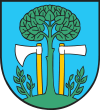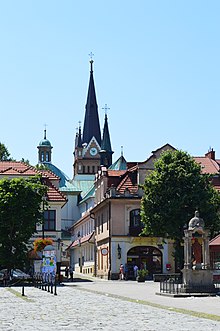Myślenice
| Myślenice | ||
|---|---|---|

|
|
|
| Basic data | ||
| State : | Poland | |
| Voivodeship : | Lesser Poland | |
| Powiat : | Myślenice | |
| Gmina : | Myślenice | |
| Area : | 30.10 km² | |
| Geographic location : | 49 ° 50 ′ N , 19 ° 56 ′ E | |
| Residents : | 18,412 (Dec. 31, 2016) | |
| Postal code : | 32-400 | |
| Telephone code : | (+48) 12 | |
| License plate : | KMY | |
| Economy and Transport | ||
| Next international airport : | Krakow | |


Myślenice is a city in the Lesser Poland Voivodeship in Poland. It is the seat of the Powiat Myślenice and the town-and-country municipality of the same name with around 43,700 inhabitants.
geography
The city is located on the Raba River about 26 km south of Krakow . The river is dammed east of the town center to the Jezioro Dobczyckie reservoir.
Myślenice has an area of 30.1 km².
history
Until 1411
The name of the town of Myślenice goes back to the medieval male first name "Myślimir".
The first written mentions are from the years 1253–1258 in the "Codex Tynieck". There a fortress is called "Mislimich". It protected the trade route between Kraków and Węgry (Hungary), which ran through Myślenice. Traces of the fortification still exist in Myślenice. The first evidence that there was not only one fortress comes from the year 1301. From the years 1325-1327 there are mentions of a wooden church. In 1342 Myślenice was granted city rights under Magdeburg law . Due to the privileges granted by King Casimir the Great , the city flourished, and the rectangular market square, which still exists today, was built at this time. In 1411 a school in the parish is mentioned.
1411-1772
In the first half of the 15th century, the city hosted high-ranking personalities several times. These included Queen Jadwiga , Władysław II Jagiełło and the German Emperor Sigismund . At that time, Myślenice was owned by John Zakliczyna . At the beginning of the second half of the 15th century, the end of the Thirteen Years' War was felt in Myślenice. During this time mercenaries were up to mischief in Lesser Poland. In 1457 Myślenice was besieged. The besiegers managed to penetrate the city. In the course of this, the city was partially looted and destroyed. In 1509 a cloth hall was built. A shelter for the poor was also built. The town continued to develop until 1557, but after that there were frequent changes of ownership. These did not care about the development of the city. In 1629, most of the buildings were destroyed in a fire. Before the city was finished with its reconstruction, Swedish units invaded, looted, and burned the city in 1655. After the war with Sweden ended in 1660, the city wanted to return to its former glory and used the right granted by the Kastellan of Krakow to hold five markets a year.
1772-1914
Since the first partition of Poland in 1772, Myślenice belonged to Galicia and was part of Austria-Hungary . During this time the name of the city was sometimes Germanized as Mischlenitz . Myślenice became the seat of a district. It was this until 1819, after which Wadowice took over this function (see the Wadowice Circle ). In 1777 the Austrians sold the city and bought it back in 1788. Trade was stimulated by the construction of the Reichsstrasse Vienna to Lemberg between 1780 and 1785 . In 1866 Myślenice was again the county seat of the Myślenice District , this was it until 1975. In 1908 the first middle school ( gimnazjum ) and the first private bus line to Krakow were opened.
1914-1939
In 1914, Myślenice provided 250 soldiers who were assigned to the 4th regiment of the Polish Legion . In the autumn of 1914 at the Battle of Kraków , Russian troops launched an offensive and were approaching Myślenice. The city was within range of the Russian artillery, and part of the lower city burned as a result of the bombardment. During the counter-offensive , the Austrian troops managed to stop the Russian army. As a result of the First World War , Myślenice belonged to independent Poland from 1918. Myślenice experienced a strong boom in the interwar period. In 1936 there were attacks against Jews by the National Party.
1939-1945
The development of the city was interrupted with the German invasion of Poland. The Wehrmacht occupied Myślenice on September 5th. On September 17th, the Soviet Union occupied the rest of Poland. The mayor Jan Dunin Brzezinski and the police commander Peter Jurczak, who were later murdered in Katyn, were among the population who fled to the east . Resistance to the occupation began to organize in the surrounding forests. On August 22, 1942, the Jewish residents of Myślenice were deported.
After 1945
The German occupation of Myślenice ended on January 21, 1945. Immediately after the occupation by Soviet troops, a wave of arrests by the Soviet NKVD began . It was directed against the intelligentsia and members of the Home Army. Land reform was also carried out and the land was divided between the landowners. In 1952 the village of Chelm was incorporated. Over the years several housing estates have been built, parts of the 1000 year old suburb have been built over. In the 1970s the road to Krakow was expanded. At the end of the 1970s, anti-communist activities also took place in Myślenice. With the agreement of August 1980, an office of Solidarność was opened.
From 1975 to 1998 Myślenice was part of the Kraków Voivodeship .
local community
The population of the municipality was 42,129 on June 30, 2010, it grew in six years to about 43,700 inhabitants.
Partner communities
- Bełchatów (Poland)
- Csopak (Hungary)
- Lüdenscheid (Germany)
- Tinqueux (France)
traffic
Myślenice is located at DK 7 . Voivodeship road 967 (ext. 967) to Łapczyca begins in Myślenice
It is around 30 kilometers to John Paul II Airport in Kraków-Balice .
Sports
The KS Dalin Myślenice plays in the Polish women's volleyball league Serie A.
Sons and daughters
- Marcin Baranski (* 1970), painter
- Radek Stawarz (* 1973), violinist
- Anna Szafraniec (* 1981), racing cyclist.
Web links
- City website (Polish)
Individual evidence
- ↑ [1] website of the city
- ↑ Dz.U. 1975 no 17 poz. 92 ( Memento from April 8, 2009 on WebCite ) (Polish)
- ↑ Główny Urząd Statystyczny, "LUDNOŚĆ - STAN I STRUKTURA W PRZEKROJU TERYTORIALNYM" ( Memento from May 15, 2011 in the Internet Archive ) as of June 30, 2010

